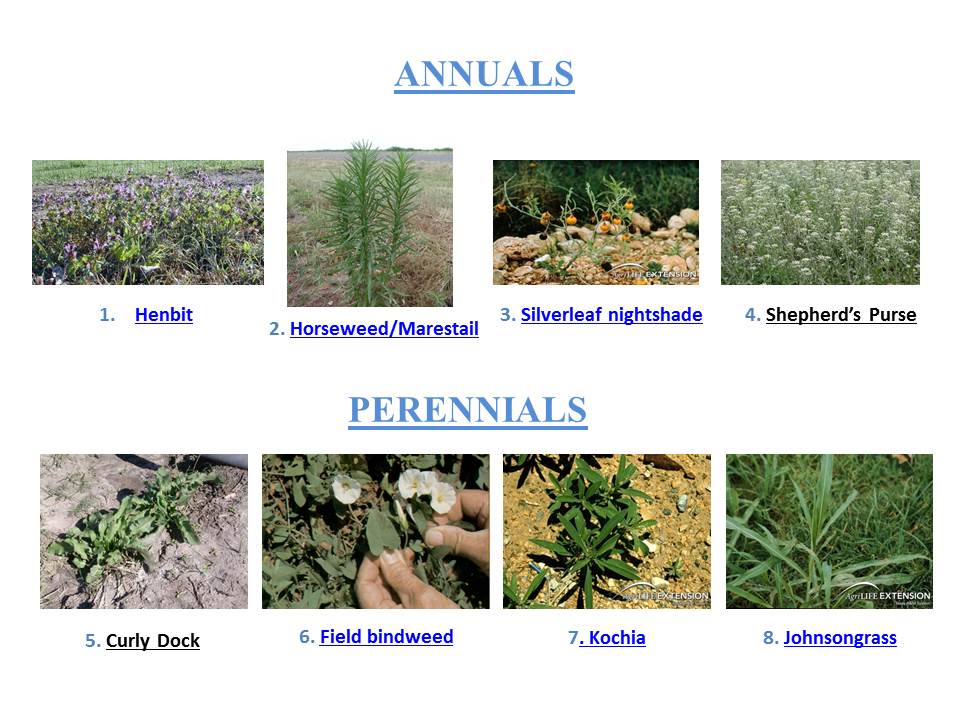by Emi Kimura and Gaylon Morgan, Texas A&M AgriLife Extension Service
Effective and season-long weed control in cotton starts with preplant weed management, starting clean to stay clean. The following herbicides are some viable options of burndown herbicides to start the 2016 cotton season with clean field.
• EPSP herbicides (Group 9)
Glyphosate (e.g., Roundup PowerMax, Touchdown Total, Touchdown Hi-Tech, and WeatherMax) controls most winter annual grass and broadleaf weeds such as henbit (Photo 1) and perennial grass such as johnsongrass (Photo 8), bindweeds, Texas blueweed, and silverleaf nightshade (Photo 3). However, glyphosate resistant pigweeds and marestail are fairly widespread across the Rolling Plains, and tank mixture with other herbicides with different herbicide group (or site of mechanism) is recommended.
• Synthetic auxin herbicides (Group 4)
Dicamba (e.g., Clarity) is a broadleaf burndown weed control option at 8 fl oz/a for weeds that are 2-4 leaf stage. Planting restrictions are 21 days per 8 fl oz/a applied and at least 1 inch rainfall or irrigation before cotton can be planted. 2,4-D is another common tankmix partner to enhance broadleaf activity when tankmixed with glyphosate. A 30 day plus 1” rain or irrigation is required before planting cotton.
• ALS inhibitor herbicides (Group 2)
Thifensulfuron-methyl + Tribenuron-methyl (e.g., Firstshot SG) and Thifensulfuron-methyl + rimsulfuron (e.g., LeadOff) controls numerous annual broadleaf weeds, such as henbit. Firstshot at 0.5-0.8 oz/a has a plant back restriction of 14 days after application and 21 days on sands, loamy sands, sandy loams, and high pH soils (> 7.9). LeadOff at 1.5 oz/a requires 30 days after application before planting cotton. Both products can be mixed with glyphosate or 2,4-D to broaden the spectrum of week control.
• PPG Oxidase herbicides (Group 14)
PPG oxidase herbicides (e.g., Aim, ETX, Goal 2XL, and Sharpen) control broadleaf weeds such as henbit (Photo 1), horseweed (Photo 2), and Kochia (Photo 7). A nonionic surfactant, crop oil concentrate or methylated seed oil is required to enhance herbicidal effectiveness in controlling emerged weeds. Contact herbicides are required to spray to seedling weeds in the 2 to 3-leaf stage with higher spray volume and appropriate nozzle for effective control of weeds. Please consult Choosing the Right Nozzle publication for specific detail on choosing appropriate nozzle.
• Photosystem I diverter herbicides (Group 22)
Paraquat (e.g., Gramoxione Inteon) controls emerged annual broadleaf weeds and grasses and suppresses perennials. Grass spp. need to be 1-6 in tall for a good control. Application rate varies between 2.5-4.0 pt/a depending on the targeted weed. Be cautious of off-target movement into adjacent wheat fields.
• Glutamine synthetase inhibitor (Group 10)
Glufosinate-ammonium (e.g., Liberty 280 SL) controls broad range of broadleaf weeds, such as chickweed, kochia (Photo 7), common mallow, morning glory, wild mustard, and pigweed and some annual grasses. Application may be made in fallow fields, postharvest, before planting or before emergence of cotton. Good coverage is essential for good control of weeds.
Carefully read the product labels especially for the moisture requirement, soil texture, and organic matter content. In the Rolling Plains, lack of precipitation is predominant issues in crop production which may limit the use of some herbicide products (e.g., 2,4-D, Clarity, Sharpen, Valor SX) that require certain amount of rainfall (irrigation) following herbicide application before cotton planting. Soil textures in some area of Rolling Plains are coarse textured soil with low soil organic matter, which again limit the use of other herbicides (e.g., Cotoran, Diuron, Dual Magnum, Sequence, and Sharpen). Soil sampling will help you identify soil texture and soil organic matter content of your soil for appropriate selection of herbicide product.
Other herbicides (e.g. Aim, ETX, Liberty, Gramoxone, and Roundup) have only foliar activity, and no soil activity or plant back restriction to cotton. With products like Gramaxone, ETX, Aim, and Liberty, are considered contact-type herbicides, where very little herbicide is translocated in the plant after the herbicide is applied. The benefit to these products is that no plant back restriction to cotton exists. However, the drawback is that these products must be applied to small weeds, higher spray volume (minimum of 10 gal/a), and appropriate tips (see Choosing the Right Nozzle publication) is required to get good weed control.
For many situations, a single herbicide may not suffice to obtain good weed control from preplant burndown heribicides, especially where glyphosate resistant weeds exist. Not all preplant burndown herbicides can be mixed together and in some situations the tank mixtures may be antagonistic. If specific tankmix partners are not included in the Weed Management in Cotton publication, refer to the product label to determine tankmix combinations and rates.
Last, read the label to determine the type and amount of active ingredient (or acid equivalent) within the various herbicides, especially if you are purchasing generic products. If the amount (lbs/gal or %) of active ingredient varies by herbicide product, the incorrect application rate will occur, impacting weed control and cost/acre of the product.
For specific details on each of the products described above and other herbicides labeled for weed control in cotton, please consult the publication ‘Weed Management in Texas Cotton’.

